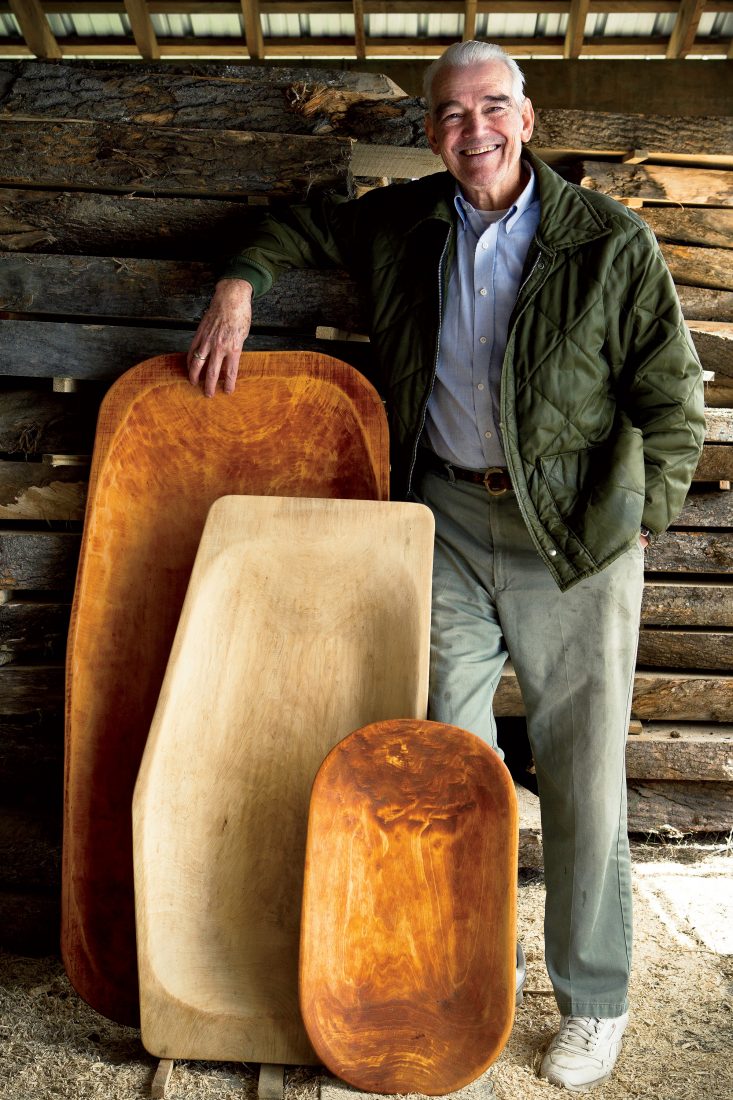For fifty-four years—more than half the life of Hemingway, South Carolina—Quinton Hughes has observed the crossroads town’s changing fortunes through the plate-glass windows of his barbershop, Hughes Hair Care. Traffic has slowed since the days when textiles and tobacco ruled. But one thing hasn’t changed: a tradition of whole-hog barbecue. And with it, a legacy of uniquely shaped honey-colored whole-hog barbecue trays, which Hughes started making nearly thirty years ago.
They might be confused with biscuit bowls—Hughes makes those, too—if not for their size. Typically measuring four feet long by two feet wide, they are large enough to serve an entire split pig over rice or enough Frogmore stew for a party of twenty. Former South Carolina governor James Edwards and his wife, Ann, own two of them. “I saw them at a barbecue dinner several years ago and knew I had to have one,” Governor Edwards says.

Photo: Terry Manier
A large hog tray ready for a party.
When Hughes, who is now seventy-four, was growing up, every household he knew of had wooden bowls and trays of all shapes and sizes. But he didn’t take up the craft himself until an encounter at his barbershop. “A regular customer—a large Santa Claus–looking man in bib overalls who could put a whole bag of chew in his mouth at one time—showed up at the shop one day and started talking about a big barbecue tray he was making out of hand tools,” Hughes says. “I wanted to needle him and said, ‘Anybody could make one of those.’ He replied, ‘I’d like to see you try.’”

Photo: Terry Manier
Taking Shape
A curved adze gets the job done the old-fashioned way.
Hughes took him up on the challenge, and today, the tin-roof shed behind his home is cluttered with tools, bowls, and trays in various stages of production. The perimeter is lined with large slabs of wood cut from the stumps of Pee Dee River tupelo gum trees. Hughes first started using the tupelo stumps because they were free—logging companies either discarded them or left them rooted in the swamps—and he liked “making something out of nothing.” But today, logging companies chop up the stumps to sell as pulp, making them much harder to come by, especially ones large enough to use for hog trays.
Hughes begins by marking the outline of the tray on the slab, using a circular saw to score the inside length and width. He uses a chainsaw to shape the outside of the tray, finishing it by sanding both sides with a power sander and then rubbing it with fine-grit sandpaper. The tray’s rich honey glow comes from an application of boiled linseed oil, which protects and seasons the wood. But even after thirty years, each tray is still a product of trial and error. “Sometimes I get to shaping and cutting and almost to finishing, and I find a crack or flaw in the wood and I have to discard it,” Hughes says. “I try to get them as perfect as I can, but with those big blocks of wood, it seems like there is always some little imperfection. No two are alike.”
He has no storefront, other than his barbershop, and if you want to purchase a bowl or tray you’d better make plans to drive to Hemingway. Just make sure to call ahead. “This is strictly a hobby for me,” Hughes says. “I might start one and take one month to finish it, and some I would do in a day. When I don’t feel right, I stop. I don’t have any deadlines because I don’t take orders.”
When he is satisfied with a tray, Hughes carefully carves a final inscription on the bottom: Created by God, shaped by Quinton Hughes. “It just came to me,” he says, “and that’s what I thought I should do.”








